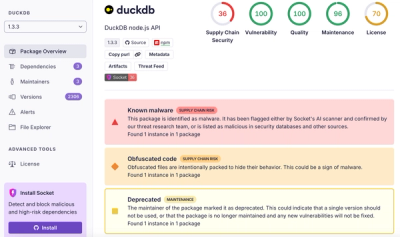
Product
Introducing Tier 1 Reachability: Precision CVE Triage for Enterprise Teams
Socket’s new Tier 1 Reachability filters out up to 80% of irrelevant CVEs, so security teams can focus on the vulnerabilities that matter.
next-i18n-router
Advanced tools
Adds internationalized routing for Next.js apps that use the App Router
With the release of the App Router, internationalized routing has been removed as a built-in Next.js feature. This library adds back internationalized routing in addition to locale detection and optional cookie usage to set a user's preferred language.
This library can be used with any of the popular Javascript i18n libraries such as react-i18next and react-intl. Tutorials and examples can be found here.
npm install next-i18n-router
First, nest all pages and layouts inside of a dynamic segment named [locale]:
└── app
└── [locale]
├── layout.js
└── page.js
Create a file called i18nConfig.js at the root of your project to store your config:
const i18nConfig = {
locales: ['en', 'de', 'ja'],
defaultLocale: 'en'
};
module.exports = i18nConfig;
Create a middleware.js file at the root of your project (or in /src if using /src directory) where the i18nRouter will be used to provide internationalized redirects and rewrites:
import { i18nRouter } from 'next-i18n-router';
import i18nConfig from './i18nConfig';
export function middleware(request) {
return i18nRouter(request, i18nConfig);
}
// only applies this middleware to files in the app directory
export const config = {
matcher: '/((?!api|static|.*\\..*|_next).*)'
};
In your root layout, add a notFound redirect for any unsupported locales:
...
import { notFound } from 'next/navigation';
...
export default function RootLayout({ children, params: { locale } }) {
if (!i18nConfig.locales.includes(locale)) {
notFound();
}
return (
...
);
}
You now have internationalized routing!
| Option | Default value | Type | Required? |
|---|---|---|---|
locales | string[] | ✔ | |
defaultLocale | string | ✔ | |
prefixDefault | false | boolean | |
localeDetector | (See below) | function | false | |
localeCookie | 'NEXT_LOCALE' | string | |
noPrefix | false | boolean | |
serverSetCookie | 'always' | "always" | "if-empty" | "never" | |
cookieOptions | (See below) | object | |
basePath | '' | string |
By default, the defaultLocale's path is not prefixed with the locale. For example, if defaultLocale is set to en and locales is set to ['en', 'de'], the paths will appear as follows:
English: /products
German: /de/products
To also include your default locale in the path, set the prefixDefault config option to true.
To hide all locales from the path, set the noPrefix config option to true.
By default, this library parses the request's accept-language header and determines which of your locales is preferred using @formatjs/intl-localematcher. This logic can be disabled or customized using the localeDetector config option (below).
Using the accept-language header is the recommended strategy outlined in the Next.js docs and is similar to the previous Pages Router implementation.
If you would prefer to handle locale detection yourself, you can set the localeDetector option with your own locale detection function:
const i18nConfig = {
locales: ['en', 'de', 'ja'],
defaultLocale: 'en',
localeDetector: (request, config) => {
// your custom locale detection logic
return 'the-locale';
}
};
module.exports = i18nConfig;
You can also set the localeDetector option to false if you wish to opt out of any locale detection.
You can override the localeDetector using the NEXT_LOCALE=the-locale cookie. For example, you can set this cookie when a user opts to change to a different language. When they return to your site, their preferred language will already be set.
If you would prefer to use a different cookie key other than NEXT_LOCALE, you can set the localeCookie option.
The serverSetCookie option automatically changes a visitor's preferred locale cookie by simply visiting a pathname that contains a locale.
'always'(default): When the pathname of a request includes a locale, that locale will be set as the cookie by the middleware. This means that locale detection and any existing locale cookie will be ignored if a locale exists in the request's pathname. Locale detection and the reading of any existing cookie will still be run on pathnames that do not include a locale.
'if-empty': Same as 'always', except the middleware will not overwrite the cookie if one already exists.
'never': The middleware will not automatically set the cookie.
If you are using noPrefix, the serverSetCookie option does not do anything since there is no locale in the pathname to read from. All language changing must be done by setting the cookie manually.
The server sets the cookie by setting the Set-Cookie HTTP response header on the NextResponse. (Learn More)
By default, cookieOptions is set to:
{
sameSite: 'lax',
maxAge: 31536000,
path: {the basePath of the incoming NextRequest}
}
You can set your own cookieOptions object containing any of the valid Set-Cookie attributes: MDN: Set-Cookie
basePath (optional)This is only needed if you are using the basePath option in next.config.js. You will need to also include it as the basePath option in your i18nConfig.
As can be read about here, you will also need to update your matcher in your middleware config to include { source: '/' }:
export const config = {
matcher: ['/((?!api|static|.*\\..*|_next).*)', { source: '/' }]
};
The current locale can be retrieved in a Client Component using the useCurrentLocale hook:
'use client';
import { useCurrentLocale } from 'next-i18n-router/client';
import i18nConfig from '@/i18nConfig';
function ExampleClientComponent() {
const locale = useCurrentLocale(i18nConfig);
...
}
The current locale should be accessed from the component's params props:
function ExampleServerComponent({ params: { locale } }) {
...
}
The maintainers of i18next recommend using react-i18next with the App Router instead of next-i18next. The popular next-i18next library is built specifically for the Pages Router. This means that if you are currently migrating from the Pages Router and use next-i18next, you will need to refactor to use react-i18next.
For a full walkthrough on setting up react-i18next with next-i18n-router (plus Google Translate/DeepL integration), see this tutorial.
You can also find an example project here.
The react-intl library works great with the App Router. But it does require a litte extra configuration for usage in Server Components.
For a full walkthrough on using react-intl with next-i18n-router (plus Google Translate/DeepL integration), see this tutorial.
You can also find an example project here.
In our example projects you will find a LanguageChanger component showing how to do this. Note that router.refresh is called after changing languages. This is because Next will not route the request through the middleware if the page happens to be cached on the client. router.refresh ensures the middleware is run on language change, allowing the locale cookie to be set properly.
This is likely because of our use of the [locale] dynamic segment. This is not a bug with this library. It is a design choice of NextJS when using a not-found page in a dynamic segment. To solve this, we recommend making the adjustment described here.
5.5.3
cookieOptions to use sameSite: 'lax' instead of sameSite: 'strict' due to infinite redirect issue described in #45FAQs
Next.js App Router internationalized routing and locale detection.
We found that next-i18n-router demonstrated a healthy version release cadence and project activity because the last version was released less than a year ago. It has 1 open source maintainer collaborating on the project.
Did you know?

Socket for GitHub automatically highlights issues in each pull request and monitors the health of all your open source dependencies. Discover the contents of your packages and block harmful activity before you install or update your dependencies.

Product
Socket’s new Tier 1 Reachability filters out up to 80% of irrelevant CVEs, so security teams can focus on the vulnerabilities that matter.

Research
/Security News
Ongoing npm supply chain attack spreads to DuckDB: multiple packages compromised with the same wallet-drainer malware.

Security News
The MCP Steering Committee has launched the official MCP Registry in preview, a central hub for discovering and publishing MCP servers.